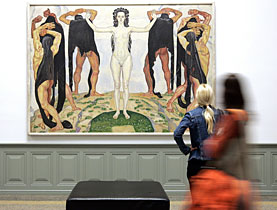Artists, friends and rivals

Ferdinand Hodler was a huge figure on the Swiss art scene at the turn of the century, but new talents Cuno Amiet and Giovanni Giacometti were snapping at his heels.
The big three of Swiss art of the late 19th and early 20th centuries are the subject of an exhibition which has just opened in Lucerne, which not only shows their works, but also reveals their friendships and rivalries.
Around 50 works from all three artists – many from private collections and some rare gems – are on display at the show, entitled Hodler, Amiet and Giacometti. Works from Central Swiss Collections, at the city’s Museum of Art.
The lion’s share of the paintings – 27 – are by Hodler (1853-1918) and include some of his most famous works, such as The Woodcutter, which was commissioned for the SFr50 note.
“Hodler is certainly the big overarching figure who really influenced a whole generation with his great works,” curator Christoph Lichtin told swissinfo.ch.
“What distinguishes his paintings is certainly how the figures are depicted, the symbolist nature of the figures. In his later works, the landscapes are certainly a high point of his painting.”
Lake Thun with the Stockhorn (1910) and the Breithorn (c.1911) are just two exquisite examples in a whole room which is devoted to the landscapes.
Hodler’s distinctive style, paring down the mountains and lakes to their essentials, made him one of the foremost artists of Alpine scenery of his time.
Hodler PR machine
The charismatic painter had many admirers – collectors as well as assorted wives and mistresses – and was extremely good at public relations.
“Hodler already started trying to win over the press as a young artist, and used the strategy of, for example, not keeping to the guidelines at competitions. He always came up with surprising imagery, causing little scandals,” Lichtin explained.
“This is exactly what you have to do also in the art scene today if you want to be successful.”
Many of his earlier works were characterised by what he termed parallelism, a clear, linear composition of figures, often depicted in interrelated poses, suggesting a dance or procession.
In 1904 Hodler had great success at an exhibition in Vienna, making the artist, who was of humble origins, into a very wealthy man. But Vienna was to prove a disaster for his younger protégée Amiet.
Amiet’s crisis
“Amiet was very strongly under Hodler’s spell at the beginning of the 20th century, and took parallelism very strongly on board,” Lichtin said.
Critics said that Amiet was simply imitating the older artist. Stung, Amiet retreated from Hodler both personally and artistically. He went to France for a year, where he became influenced by van Gogh and Cézanne, absorbing their way of painting and using colour.
The Solothurn-born artist, who had to at first convince his civil servant father to let him paint, is now considered to have made a significant contribution to the resurgence of Swiss painting.
One of the exhibition’s highlights – also on its poster – is Amiet’s Dandelion Field (1903), a huge canvas of green and gold, which has rarely been seen in public.
Amiet was close friends with Giacometti, who was the same age and whom he had met in Munich when studying art there. Amiet was godfather to Giacometti’s son, the famous sculptor Alberto.
Giacometti’s colour
“What was special about Giacometti was that the subjects were not the most important thing for him, but how the colour ran through these subjects,” the curator said.
This can certainly be seen in the Giacometti room of the exhibition, with paintings in bright, vivid colours.
The play of light was also another theme, beautifully shown in The Reading Woman, a late addition to the exhibition – it was offered at the last minute by a collector who had read about the show – depicting a woman reading with the aid of candle, the light shown in her face.
Giacometti liked to paint his family, as well as local people and landscapes around his home village of Stampa in a valley in the Engadine.
Many of Giacometti’s sales took place in Engadine, then a popular place with international guests, but he also sat on national commissions and kept up to date on what was happening in the art world with trips abroad.
Rivalry and legacy
Amiet and Giacometti supported each other, often exhibiting together. “Hodler was certainly a rival for the two younger ones and they had to assert themselves,” Lichtin said.
“Hodler had his market position and his name, so it was more difficult for the others,” he told swissinfo.ch.
The three did however exhibit together in 1898 in Zurich and even planned a joint project for the Paris World Fair two years later, which unfortunately ran out of funds.
Hodler died in 1918. “They had an open field in Swiss art after Hodler’s death,” said Lichtin.
Giacometti lived on until 1933. Amiet survived him by almost 30 years, living to the age of 93.
The three artists, says the museum, exercised the greatest influence on modern Swiss art. They all operated in the spirit of openness and all three wanted to respond to the artistic movements in Europe at the time – and help shape them.
“I think we have managed to make a small but beautiful exhibition which gives a good insight into the works of these three artists,” Lichtin said.
“There are some highlights, such as the landscape room with the later landscapes from Hodler, which is one of the best of its kind that people can see at the moment in Switzerland.”
Isobel Leybold-Johnson in Lucerne, swissinfo.ch
The exhibition opened on July 10 and runs until October 10, 2010 at the Museum of Art Lucerne.
There are around 50 works featured, including the well known works from the museum’s collection and 30 loans from private collections.
The Woodcutter on show is one of several Hodler painted. The famous one, captured in a photo seemingly swinging his axe above the head of former Justice Minister Christoph Blocher, the rightwing People’s Party figurehead – belongs to the government.
The museum, situated in the Jean Nouvel-designed Culture and Congress Centre in Lucerne, has just celebrated its 10th anniversary.
Giovanni Giacometti’s son Alberto was born in 1901. His international fame was to be greater than his father’s. Alberto began to draw and sculpt at a very young age, later studying art in Geneva and Paris.
He came into contact with the major artists and intellectuals. His figures, such as Walking Man, are probably his best-known works.
Alberto became increasingly well known in the mid-1950s in Europe and the US. He died in January 1966 and was buried at the village of his birth.
His bronze statue, L’homme qui marche I (Walking Man I), broke the record for a work of art at auction, selling for $104.3 million (SFr110.67 million) at Sotheby’s in London in February 2010.

In compliance with the JTI standards
More: SWI swissinfo.ch certified by the Journalism Trust Initiative













You can find an overview of ongoing debates with our journalists here . Please join us!
If you want to start a conversation about a topic raised in this article or want to report factual errors, email us at english@swissinfo.ch.